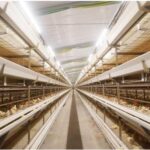In today’s poultry industry, efficiency and automation are the driving forces that determine profitability and sustainability. For egg producers across Africa, where demand for quality eggs continues to grow, the need for reliable layer cage systems has never been greater. A 30,000-bird capacity A type layer cage system equipped with an automatic feeding line, egg collection conveyor, manure removal, and climate control units is an ideal investment for commercial farms that want to maximize egg output while minimizing labor costs.
This article explores how the A type cage design addresses the specific challenges of African poultry farms, why automation is a necessity rather than a luxury, and what long-term economic advantages farmers can expect.

Why Choose an A Type Cage System?
The A type cage system is named after its A-shaped structure, which provides strength, stability, and excellent ventilation for layer birds. Unlike traditional deep litter housing, the cage design allows higher stocking density, easier cleaning, and more efficient feed management.
For a farm of 30,000 layers, manual management becomes extremely difficult. Labor costs rise, egg breakages increase, and disease risks multiply. The A type system solves these issues by:
- Organizing birds in multiple tiers.
- Ensuring uniform feeding and watering.
- Allowing manure to drop directly onto the conveyor belt for automatic removal.
African farms located in hot climates such as Nigeria, Ghana, or Kenya benefit especially from the airflow provided by this cage style, which reduces heat stress and improves egg production rates.
Automatic Feeding System: Precision and Savings
Feeding is the single largest expense in poultry farming, accounting for nearly 70% of production costs. Traditional hand feeding not only wastes time but also results in feed spillage and uneven distribution.
With the layer chicken cage automatic feeder:
- A centralized hopper distributes feed evenly across all cages.
- Each bird receives the same ration, improving uniform growth and uniform egg size.
- Energy-saving motors reduce electricity costs.
- Precise control over feed quantity minimizes waste.
For African farmers who often face fluctuating feed prices, this precision helps stretch resources further while ensuring the flock stays healthy.

Automatic Egg Collection: Protecting Quality and Reducing Breakages
Egg collection by hand in a 30,000-bird farm can take several hours daily and inevitably leads to breakage, dirt, and losses. The layer chicken cage automatic egg collector is designed to gently transport eggs from each tier to a centralized collection table.
Advantages include:
- Lower egg breakage rates (often less than 1%).
- Clean eggs with minimal handling, which meet market hygiene standards.
- Labor savings—only one or two workers are needed to pack eggs instead of dozens.
- Faster delivery to storage or trucks for market transport.
For countries like Uganda, Tanzania, and Zambia, where urban markets demand large volumes of fresh eggs daily, this system ensures timely and safe supply.

Manure Removal and Environmental Control
Accumulated manure in poultry houses leads to ammonia build-up, fly infestations, and disease outbreaks. In tropical African climates, this problem is even more serious.
The A type system is integrated with belt-driven manure removal equipment, which regularly removes droppings from beneath cages and carries them outside the house. This keeps the house environment cleaner, reduces odor, and minimizes health risks for both birds and workers.
Additionally, optional ventilation fans, cooling pads, and automated temperature control systems help stabilize the poultry house climate, essential in regions with extreme heat.

Economic Benefits for African Poultry Farms
Investing in a 30,000-layer A type cage system may seem like a major expense, but the long-term benefits make it highly cost-effective:
- Higher production efficiency – More eggs per bird thanks to reduced stress and uniform management.
- Lower labor costs – Fewer workers are needed for feeding, cleaning, and egg collection.
- Better egg quality – Clean, intact eggs fetch higher prices in local and export markets.
- Improved flock health – Disease prevention through better hygiene and manure management.
- Faster return on investment – Many African farmers recover costs within 1–2 years.

Case Study: Nigerian Commercial Egg Farm
One of our customers in Ogun State, Nigeria upgraded from deep litter housing to a 30,000-bird A type cage system. Before the upgrade, the farm required 25 workers daily. After installation, labor requirements dropped to 2 workers, egg breakage decreased by 60%, and overall egg output increased by 18%. The investment was fully recovered within 14 months.
Why Automation Matters in Africa’s Poultry Industry
The African poultry industry is rapidly modernizing. With urban populations growing, egg consumption is rising across countries such as Ethiopia, Kenya, and South Africa. Farmers who continue using traditional systems risk falling behind in terms of efficiency and market competitiveness.
Automation enables African poultry farmers to:
- Meet rising demand without expanding land use.
- Ensure food security by producing affordable protein.
- Position themselves for future export opportunities.
Conclusion
For African egg producers aiming to expand production while controlling costs, the A type cage system for 30,000 layers with automatic feeder and egg collector is an ideal solution. It provides consistent performance, reduces labor dependency, and secures better returns.
By adopting such modern systems, African farmers not only improve their own livelihoods but also contribute to the continent’s broader goal of agricultural modernization and food self-sufficiency.






